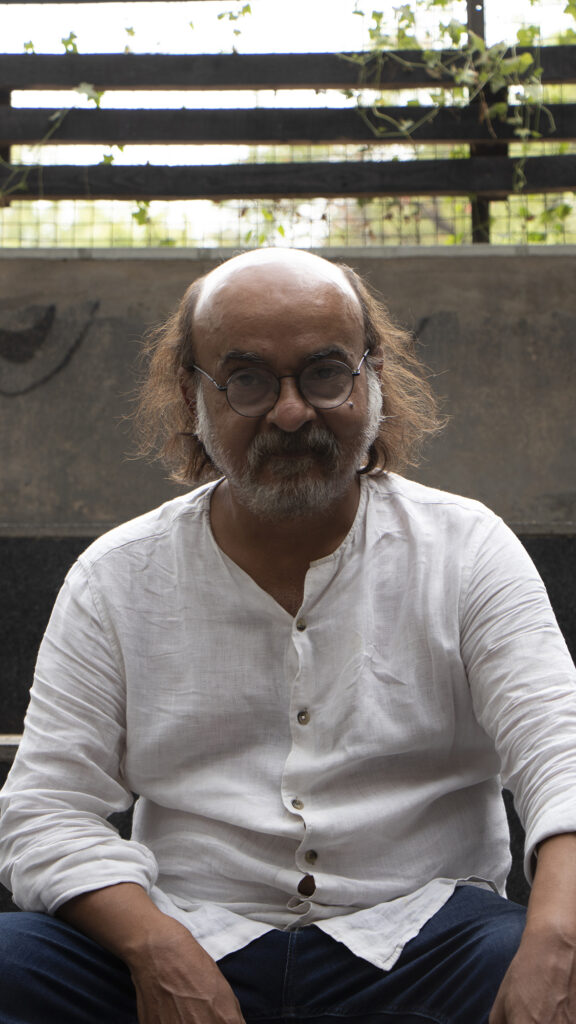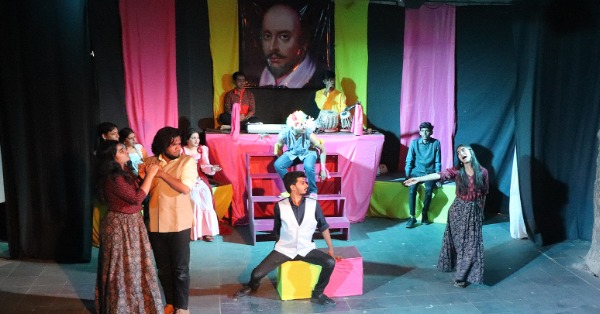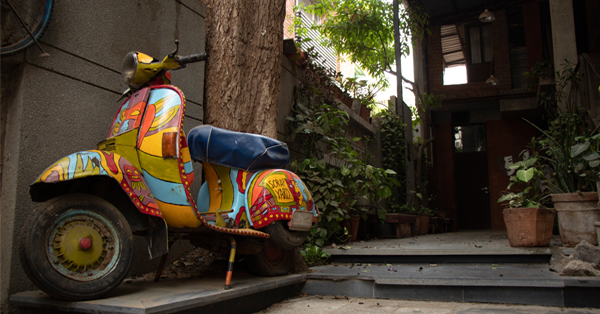I am driving by the Sabarmati in Ahmedabad along the city’s showcase riverfront. The water is bound on both sides by sheer, stern walls and promenades of pure brown concrete. The promenades baking in the sun seem broader than the river. They run down to the river in layers – right up to the water’s edge. No mud, no moss, no mess. This is a lot of concrete – a LOT – interspersed with embarrassed trees that seem to feel out of place in this unapologetic ode to a very urban architecture that is geometrically clean and purposefully clinical. No accident of the natural is allowed to blemish it, to soften it, to nuance it. Everything and everyone have been cleared out to make way for the concrete. It is empty, it feels empty.
I’m on my way to the Scrapyard Theatre to meet Kabir Thakore, architect and theatre person, who has converted the backyard of his house into a DIY theatre space. The house is down a side-lane in the Paldi neighbourhood. As I enter the gate, I notice a two-wheeler painted a bright yellow. It’s a piece of scrap-art gleefully singing out the name of the theatre. I walk past this to my left and the house to my right: a staircase runs up the side of the house wall, beginning with iron steps and then wooden ones. More scrap? Straight ahead is a sort of outhouse abutting the main structure. I enter, there’s a pantry to my left and a rough-and-ready make-up room to my right with mirrors and a mix of chairs. And beyond that I see the amphitheatre. An open space with a stone floor and layers of seating, embraced from above by a leafy tree that leans over eagerly to watch whatever may be on offer. The space is empty, but it feels full.

Kabir meets me here accompanied by some of the young people who have made theatre – and this theatre space – their home. Over the last five years, Scrapyard has built a community of about 70 to 80 people who work here. They multitask – it’s a non-hierarchical, democratic shared space. They interchange roles to support each other’s work from directing, to acting, to production work, to selling tickets, to manning the foyer… More than 25 directors have debuted here over the last five years, and the space has spawned young groups in the city who have branched out to make their own work, bringing it back to Scrapyard to show and share. Income from ticket sales usually covers a small fee for the cast and crew, but nothing that could make this a sustainable profession for them. Kabir has plans for that – registering as a non-profit entity eligible for public and private funding being one of them. As an aside, he mentions that the Gujarat government spends Rs. 50 crore on Culture every year. Where does it go, we both wonder? But for Kabir, the challenge is not how to make Scrapyard sustainable, but how to nurture a certain vibrant, experimental theatre culture that has been created. His mantra is “If you can’t survive on theatre, at least make theatre survive”.
Cups of tea arrive as we talk. This is unsurprising – this is a theatre space, after all! Scrapyard evolved out of practically nothing, “by collecting scrap from society, because theatre is scrap for society” quips Kabir. Indeed, everything was made from collected material to begin with. The flooring is from stones he had left over from another building site, for example. Even their first lights were made from scrap: flex cylinder rolls with embedded low-power halogens created stage spots, and fan regulators were modified to create dimmer boards. Over the years, they have begun, of course, to collect more ‘proper’ equipment, but their old lights remain and still work in tandem with the new ones.

But another quip underlines why he felt the need to create this alternative space. He felt theatre in Ahmedabad was stagnating, using old content and creating scraps; here, they collect scraps to create new, experimental content in response to the times we live in.
To give me some context, Kabir recalls the heyday of Gujarati commercial theatre in the 1960s and 1970s. Plays featuring the popular duo Pravin and Sarita Joshi would open in Ahmedabad and run for one month either at the Town Hall or at Premabhai Hall. There would be long queues at the store Parekh’s where tickets would be available. The state of Gujarat also has a longstanding tradition of inter-college one-act play competitions. This youth theatre festival was initiated in the 1980s by a local newspaper – Gujarat Samachar – and still continues every year at the Thakorbhai Desai Hall. Originally, colleges from across the state would join tempted by the promise of coverage, but soon participating in the festival became a matter of prestige. Several well-known names in theatre and film such as Abhijat Joshi, Saumya Joshi and Kabir himself are products of this. The problem was that the prospects seemed barren after college. There was no healthy commercial or experimental theatre happening in Ahmedabad to take forward this energy. Most of those who continued moved to Bombay. Additionally, there was very little safe space to create political and anti-establishment theatre. This is the vacuum that Scrapyard attempts to fill. Several years down the line, there are now other alternative and privately-run spaces such as Prayogshala and Footlights, all of whom host a variety of work on a regular basis. Scrapyard itself has produced six new plays since the lifting of the lockdown in November 2020, each directed by a different person and featuring a different cast. Kabir calls the space “a maternity ward for theatre directors and actors”.
Kabir first began work in the premises of Rangmandal – a trust dating back to pre-Independence days. Soon after in 2014, Rangmandal produced the Ahmedabad Rang Mahotsav – a festival and competition open to both college and amateur groups. Despite being a competition with a range of prizes on offer, the event was designed to create an atmosphere of performance and participation that would draw people in, with additional programmes such as platform performances as well as professional performances. This focus on creating access and engagement continues at Scrapyard which was born about five years ago. Gujarati theatre audiences tend to be middle-aged – a sure sign of fading relevance and interest. But on an average, every play that Scrapyard has hosted has had 30-odd new faces in the audience – people who have never seen theatre before, but now come to see a friend or family member on stage. About 5000 new audience members have been created in the last five years. Scrapyard seems to have nurtured a young theatre community both on and off stage – a community keen on imagining and creating work that speaks directly to the times.

One such play Kabir wrote before Scrapyard came into being is Tale of Tears – a dual response to the heinous Delhi rape case of 2012 and to the various verdicts regarding the 2002 riots in Gujarat that were being delivered at the time. The play is a study of family responsibilities, roles and reactions as a lawyer successfully defends her father against charges of rape and murder during the riots, only to find out that he is – in fact – guilty. Kabir was able to produce the play at that time with several performances, but would refrain from doing it in the current climate in the state and the country. You could talk to the fence-sitters then, and win them over, he says. The lines in society are very clearly drawn now.
One now also has to think of protecting the Scrapyard space – not just as the physical entity, but also what becomes possible there. The draconian Dramatic Performances Act is in force in Gujarat, with several restrictions, censor issues, and convoluted procedures and expenditure to get permissions. Scrapyard is a relatively small endeavour, and the balancing act with authorities is difficult to maintain. The real danger though, ironically, comes from the audience. With numbers growing, spectatorship has moved out of the zone of familiarity. New, unknown faces join in – and this is very welcome. But there is always the fear and possibility of a right-wing presence, whether intentional or accidental.
Audiences are also diverse, and Scrapyard has begun producing plays that target specific audience groups. One such is children – and this came about without an actual plan. Kabir was approached by the veteran novelist, playwright and translator Dhiruben Patel (who is now 94 years old) to write and create a play for children. Kabir, with his history of very socio-political theatre, wasn’t keen – but she would not take no for an answer. She was even funding it! And so Mowgli Balloo Tanak Tumtum was born – and along with that was born a new audience of children and their extended families. The play has been performed to full houses more than 20 times so far.
New content, experimental and diverse work, and young blood definitely have a lot to do with Scrapyard becoming a hub, but Kabir also points out the design of the theatre. The open-air space is inspired directly by Prithvi Theatre in Bombay – the dimensions of the stage area are apparently exactly the same, and the continuous bench-like seating also reflects the audience area at Prithvi. The proximity this kind of a space affords also creates an intimacy with an audience that captures their imagination and involvement. Prithvi was designed and built by the architect Ved Segan. Before he designed it, he was charged by Shashi Kapoor and Jennifer Kendal with visiting as many theatre spaces as possible and watching performances in them to help him discover what the Prithvi Theatre should look and feel like for both actors and audiences. It is no wonder that Prithvi Theatre’s design inspires Kabir – both an architect and a theatre-person.
Like Prithvi, Scrapyard is in a residential area, and there are often problems with the neighbours. It is too loud, it attracts too many people, it creates traffic issues… these are the various complaints. In fact, parking is not allowed in the neighbourhood specifically for those visiting Scrapyard, the local dance class or the branch of the Red Cross Society which is in a parallel lane. Of course, people would not have a problem with a mandir, laughs Kabir. The difference, according to Kabir, is that a space like Prithvi is looked upon with pride by the people of Bombay. They feel it is part of the city’s identity. Not so in Ahmedabad, where such spaces don’t count – though Kabir was once gifted a cultural map of the city with Scrapyard marked on it as an appreciation of his work.
As I left Scrapyard and turned back towards the river, I could not help wondering what kind of spaces do count then in defining and nurturing the identity, culture and pulse of a city: spaces like Scrapyard or spaces like the Sabarmati Riverfront?






